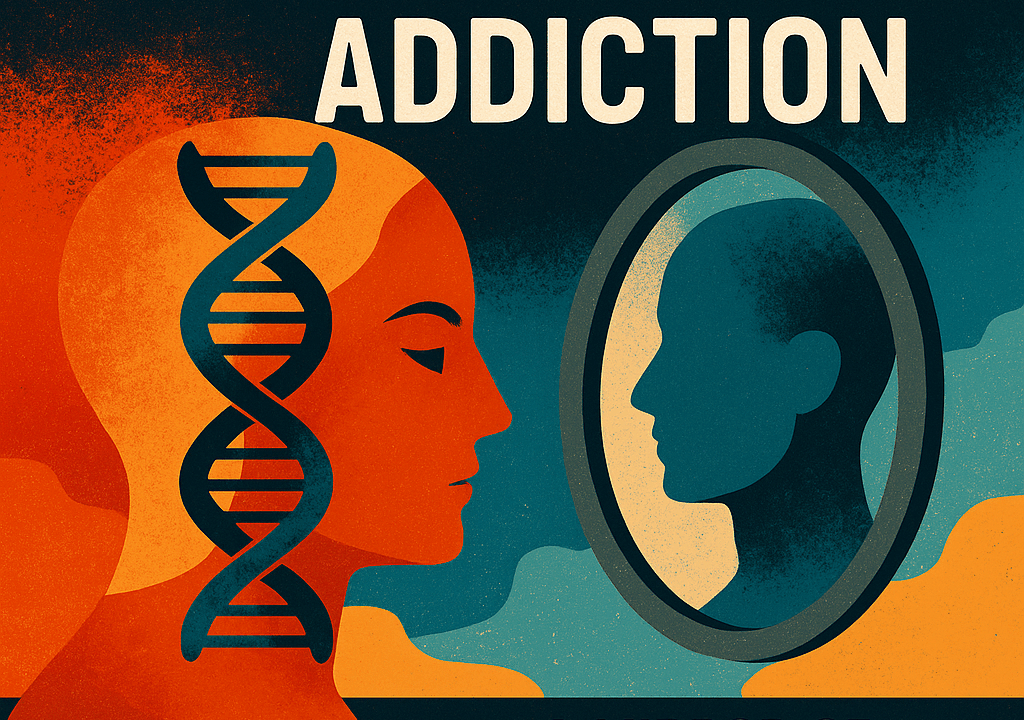The word epigenetics comes from the Greek prefix epi- meaning “above” or “on top of” and the word genetics. It refers to the study of changes in gene expression that do not involve alterations to the underlying DNA sequence—essentially, it’s how life tunes the instrument of the genome based on the music of the environment.
First coined by embryologist Conrad Waddington in the 1940s, epigenetics has emerged from the realm of theory into the heart of modern biology. We now know that while genes provide the blueprint, it is the environment—the relationships, traumas, love, stressors, food, toxins, and culture—that plays the symphony.
And it’s here, in this strange ballet between proteins and context, that we find ourselves confronting a long-standing misunderstanding in the addiction field: that people are predisposed—almost cursed—to become addicts.
This belief often smuggles in a kind of fatalism: that addiction is a genetic time bomb, just waiting to explode. But epigenetics tells a more nuanced, and in many ways, more hopeful story.
The Ghost of the “Alcoholic Gene”
There was a notable cultural shift in the late 1990s, when outlets like Time, Life, and other popular media sources promoted headlines that claimed scientists had found “the alcoholic gene.” Around 1990, researchers identified a gene variant—ADH1B—that was associated with how some individuals metabolize alcohol, influencing their physiological response. These findings were real, but their portrayal in the media was often a half-truth at best.
Instead of highlighting that this gene might affect sensitivity to alcohol or how it’s processed in the liver—similar to how diabetes involves insulin sensitivity—headlines implied a deterministic fate: that some were biologically doomed to become alcoholics.
This oversimplification ignored what science now affirms through the study of epigenetics: genes are influenced by life. The presence of a gene is not a sentence—it’s a possibility that is shaped, activated, or silenced by experience, especially trauma.
To date, no single “alcoholic gene” has been found that determines addiction. And while some genes may create vulnerability, they don’t dictate destiny. The National Institute on Alcohol Abuse and Alcoholism (NIAAA) now emphasizes that addiction is the result of multiple genetic and environmental factors (NIAAA, 2021).
Trauma as the Activator
Epigenetics shows us that genes are not fixed scripts. Instead, they respond to the cues of experience. Through chemical modifications—like DNA methylation or histone modification—certain genes are turned “on” or “off,” influencing how cells behave and, by extension, how a person thinks, feels, and reacts to the world.
In the case of addiction, research suggests that it isn’t just the presence of “addictive genes” that matters, but how those genes are expressed in response to trauma, stress, or neglect. As neuroscientist and physician Dr. Gabor Maté explains, “Not all addictions are rooted in abuse or trauma, but I do believe they all can be traced to a painful experience. A hurt is at the center of all addictive behaviors.”
Studies support this. For example, a review in Nature Neuroscience (Nestler, 2013) outlines how exposure to early life stress can lead to epigenetic changes that affect the brain’s reward circuitry—making some individuals more susceptible to compulsive behaviors and substance use later in life.
In other words, trauma may act as a switch, activating predispositions that were otherwise dormant. The individual isn’t broken—they’re responding, sometimes intelligently, to an environment that failed to provide safety or regulation.
So when someone finds powerful relief in substances like fentanyl or alcohol, it’s not because they’re doomed. It’s because their system, through the prism of epigenetics, has learned that this chemical interruption of pain works. At least for a while.
Recovery: An Environmental Shift
But here’s the miracle: because epigenetic changes are influenced by environment, they are not only activated by it—they can be reversed or reshaped by it. This is where recovery lives.
Recovery is not just about abstaining from substances; it’s about altering the environment—internally and externally—so that new, healing proteins get expressed. You see this in family systems therapy, in secure group attachments, in somatic work, and in purpose-driven community. These forms of treatment don’t just treat the individual—they rewire the atmosphere.
Epigenetics is not a curse. It’s a mirror. And if the mirror has reflected pain, shame, or trauma, it can also reflect safety, love, and transformation.
Recovery communities have been, sometimes unknowingly, doing epigenetic work for decades. By replacing chaos with connection, isolation with belonging, and shame with story, they change the molecular music of people’s lives.
This isn’t just poetic—it’s biological.
In a world that often feels predetermined, epigenetics offers a strange, soft rebellion. It whispers: you are not doomed. The forces that shaped you can be reshaped. With time, attention, and care, even the deepest molecular scars can soften.
And that, in itself, is empowerment.
SOURCES:
- Waddington, C. H. (1942). The Epigenotype. Endeavour.
- Nestler, E. J. (2013). Epigenetic mechanisms of drug addiction. Nature Neuroscience, 16(5), 510–518.
- Maté, G. (2009). In the Realm of Hungry Ghosts: Close Encounters with Addiction. Vintage Canada.
- Roth, T. L., et al. (2009). Lasting epigenetic influence of early-life adversity on the BDNF gene. Biological Psychiatry.
- NIAAA. (2021). Alcohol Use Disorder: A Genetic Perspective
- Los Angeles Times (1990). Gene That May Predispose to Alcoholism Identified
